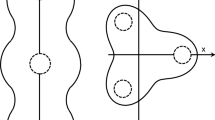Abstract
We present calculations of a number of properties of electron bubbles in liquid helium. The size and shape of bubbles containing electrons in different quantum states is determined based on a simplified model. We then find how the geometry of these bubbles changes with the applied pressure. The radiative lifetime of bubbles with electrons in excited states is calculated. Finally, we use a quantum Monte Carlo method to determine the properties of a bubble containing two electrons. We show that this object is unstable against fission.
Similar content being viewed by others
References
H. J. Maris, J. Low Temp. Phys. 120, 173(2000).
In most papers on electron bubbles the different states are described as nS, nP, etc, where n is the radial quantum number. Thus, in atomic physics notation the state that we refer to as 1P would be called 2P.
V. Elser, J. Low Temp. Phys. 123, 7(2001).
A. I. M. Rae and W. F. Vinen, J. Low Temp. Phys. 123, 1(2001).
A. Y. Parshin and S. V. Pereversev, J.E.T.P. Lett. 52, 282(1990).
C. C. Grimes and G. Adams, Phys. Rev. B 45, 2305(1992).
J. A. Northby, Ph.D. thesis, University of Minnesota (1966), unpublished
J. A. Northby and T. M. Sanders, Phys. Rev. Lett. 18, 1184(1967).
C. L. Zipfel, Ph.D. thesis, University of Michigan (1969), unpublished
C. L. Zipfel and T. M. Sanders, in Proceedings of the 11th International Conference on Low Temperature Physics, J. F. Allen, D. M. Finlayson, and D. M. McCall (ed.), St. Andrews University, St. Andrews, Scotland (1969), p. 296.
C. C. Grimes and G. Adams, Phys. Rev. B 41, 6366(1990).
H. J. Maris and D. Konstantinov, in Proceeding of the Advanced research Workshop on Liquids Under Negative Pressure, Budapest, (February 23-25, 2002), to appear.
W. B. Fowler and D. L. Dexter, Phys. Rev. 176, 337(1968).
B. DuVall and V. Celli, Phys. Rev. 180, 276(1969).
T. Miyakawa and D. L. Dexter, Phys. Rev. A 1, 513(1970).
P. B. Lerner, M. B. Chadwick, and I. M. Sokolov, J. Low Temp. Phys. 90, 319(1993).
The periods of the lowest order vibrational modes of the bubble lie in this general range. Of course, if the damping of the motion of the bubble wall by rotons and phonons is large, the time scale will be larger.
For references to the adiabatic principle, see L. D. Landau and I. M. Lifshitz, Quantum Mechanics, 2nd ed., Pergamon, Oxford (1965), Sec. 41, p. 142and
L. I. Schiff, Quantum Mechanics, 2nd ed., McGraw-Hill, New York (1955), Sec. 31.
D. Konstantinov and H. J. Maris, J. Low Temp. Phys. 121, 615(2000).
We thank B. J. Mares and N. Kapoleas for comments on this point.
J. von Neumann and E. P. Wigner, Phys. Z. 30, 467(1929). Note that as far as the von Neumann-Wigner discussion is concerned, a bubble described by and is effectively a one parameter system because only the parameter affects the relative energies of different states.
H. C. Longuet-Higgins, Proc. Roy. Soc. London Ser. A 344, 147(1975).
M. V. Berry and M. Wilkinson, Proc. Roy. Soc. London Ser. A 392, 15(1984).
D. R. Yarkony, Rev. Mod. Phys. 68, 985(1996).
We say “towards zero” for the following reason. With our numerical method for the calculation of the total energy, we can show that in the 1F state the energy initially decreases as the waist is reduced. However, as already noted the numerical method breaks down when the waist becomes very small. Thus, we cannot prove that the energy decreases continuously as the radius decreases all the way to zero.
See, for example, the results given on pp. 253 and 254 of H. A. Bethe and E. E. Salpeter, Quantum Mechanics of One-and Two-Electron Atoms, Academic, New York (1957).
This near cancellation means that our result for the 2P to 1S lifetime is likely to be much more sensitive to the approximations introduced in the model than are the results for the lifetimes of the other processes.
See, for example, the table of dipole moments listed on p. 264 of Ref. 24.
D. L. Dexter and W. B. Fowler, Phys. Rev. 183, 307(1969).
This is the result obtained by Dexter and Fowler under the approximation that the electron wave function vanishes at the bubble wall. Note that they use a surface tension of 0.36 ergĊcm−2.
V. B. Shikin, JETP Lett. 27, 39(1978).
M. M. Salomaa and G. A. Williams, Phys. Rev. Lett. 47, 1730(1981).
K. W.-K. Shung and F.-L Li, Phys. Rev. B 45, 7491(1992).
Author information
Authors and Affiliations
Rights and permissions
About this article
Cite this article
Maris, H.J. Properties of Electron Bubbles in Liquid Helium. Journal of Low Temperature Physics 132, 77–95 (2003). https://doi.org/10.1023/A:1023745209220
Issue Date:
DOI: https://doi.org/10.1023/A:1023745209220




